Winter is that time of the year when you have to store your favorite bike away, but want to make sure it is kept well protected to be ready for use in the next season.
Depending on your region, winter temperatures and humidity levels can have varying impacts on your bike if left outdoors as is. Having a better understanding of your climate and humidity levels, you can keep your bike protected from getting frame rust and flat tires by taking protective measures.
We know bikes are made up of metal parts including frame and drive assembly and rubber/plastic parts such as tires, tubes, wire casings, and brakes. These parts are susceptible to colder temperatures and moisture levels that enhance in the winter season and require careful planning when storing them away.
In this article, we will go over various factors in detail that can impact your bike and how to protect it during winter storage to enhance its lifespan.
Are your Bike Tires properly Inflated?
Properly inflated tires are very essential for protecting them from developing cracks when stored in cold weather. For winter storage, use the higher tire pressure value in the table below.
| Road Bikes | Mountain Bikes | Kids Bikes | Hybrid Bikes |
| 80 – 130 PSI | 30 – 50 PSI | 20 – 40 PSI | 50 – 70 PSI |
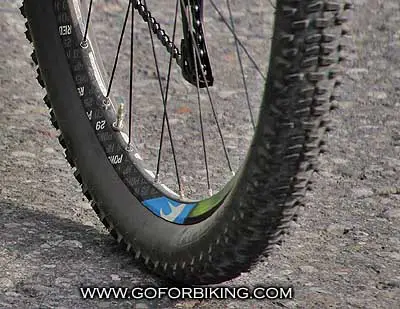
Store your Bike Washed and Cleaned
Before storing your bike for the winter season, get it all washed and cleaned up. This will not only protect your bike frame from rust caused by moisture trapped in dirt patches but also protect the tires from developing cracks over the storage time.
Usually, the dirt and mud stuck to the tires and frame will trap moisture and erode the impacted surface whether it is the frame, drive assembly, or tires. Therefore, storing a clean bike not only protects it from degrading but also keeps it ready for the summer season without much effort put in.
Lubricate your Bike Chain and Drive Assembly Before Storage
It is best to lubricate your bike chain and drive assembly with bike chain lube before storing it. It adds a protective layer on the metal surface stopping an air and moisture contact that normally leads to oxidation, resulting in forming rust.
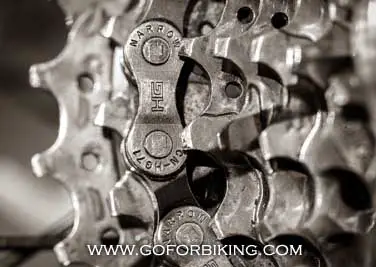
You should strike a normal balance when lubricating your bike chain and drive assembly including derailleur, cogs, and cassette to avoid excessive oil. In case some parts get excessive oil, wipe it out with an absorbent rag or paper towel since it can collect and trap dirt over time.
Although chain lube is best to use, in its absence, WD-40 can also come in handy to get the job done for a temporary moisture deterrent barrier. Later, you should apply the Bike Chain Lube to keep it protected from rust for long.
Unmount Electronic Gadgets from the Bike During Winter Storage
As Electronic parts are more susceptible to damage in cold temperatures, it is best to remove all electronic gadgets including bike computers, GPS units, and cameras during winter storage. For electric bikes, it is best to remove the battery and charger and store it inside the house in a warmer climate.
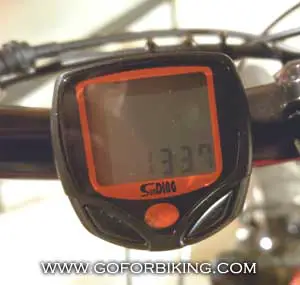
It is also the best time to check on and remove the batteries out of the electronic gadgets, since they may tend to leak and form rust inside causing damage to the device.
Remove Handlebar Grips
Bike handlebar grips are made of rubber and plastic material that tends to degrade in colder temperatures. Taking them off during winter storage will protect them from damage and increase their life span.

Removing handlebar grips has been one of the tougher jobs I had to deal with, as they just won’t come off easily until I found a solution for it that am glad to share with you below:
How to Remove Bike Handlebar Grips Easily?
The best way to remove handlebar grips is using a thin Hex-Key and rubbing alcohol. Slide the long end of the Hex-Key into the grip and pour in rubbing alcohol to get inside. Try this on at least 3 sports around the grip and give it a quick wiggle to release and it will come off very easily.
Quick Tip: You can also alternate rubbing alcohol with nail polish remover which is more commonly available around the house.
Make sure to protect your eyes with work glasses and put on your work gloves when working on your bike, often times we just ignore it until getting a poke and then realize. It has happened to me a few times, so now it is a must-have starting step for me.
Remove the Saddle and Saddle Post
It is recommended to take off the seat post along with the saddle during winter storage and keep it inside to protect it from degrading. Also, lubricate the seat-post tube on the frame from inside. This will help protect it from rust and also make the re-installation easy when ready.

Some people apply grease instead of the bike oil, which is perfectly fine, however, excessive amounts should be avoided.
Should I Deflate My Bike Tires In The Winter?
Since cold temperatures in winter compress the air density, the tire pressure drops by a few points, which is quite normal. Deflating the tires completely may not be a good idea as it can lead to degrading the inner surface of the tire and/or tube over time leading to cracks and shortening its lifespan.
When you deflate the tire completely in the Winter season, where the bike sits in a storage unused for months, will cause them to dry rot.
Now you must be wondering, What is Dry Rot?
Dry Rot happens when the oils and resins in the rubber of the tire, that keep it moist, will dry out due to an idle period. These oils and resins are necessary for the longevity of the tire and get activated by the spinning mechanism of the tire when it comes in contact with the road with Rider on.
After months of storage and getting it ready for a ride, upon inflating the tire in which dry rot spots are developed over time, the added pressure will force those weak points to crack the inner wall of the tire and make it unusable.
It is recommended to leave the tires inflated in winter and even better to have it hanging on a wall or ceiling mount which will further protect one spot of the tire coming in contact with the ground for a long period.
Do Bicycle Tires Go Flat In Cold Weather?
Keeping the tire pressure of a bike in cold weather is more important than warm weather due to the compression in air density causing the tire pressure to drop. As a general rule, usually with every 10 degrees temperature drop, the inside pressure of the tire drops by 2% PSI.
Although the pressure drop in tires due to cold weather may not seem significant when you have fully inflated tires going into cold weather, tires with lower pressure can completely deflate. This leads to a Dry Rot condition developing cracks in the inner lining of the tires to get them flat.
Complete tire deflation for longer periods of time especially in cold weather and winter season must be avoided, rather keep them inflated before the winter season to prolong the life of tires.
You should also avoid inflating tires outdoors in freezing cold and/or frosty conditions since the Schrader valve does not seat properly due to frost build-up around the rubber seal causing damage to the valve due to which the tire go flat.
Although tires can be repaired/patched depending on the damage, the degradation in the tires will make them somewhat unreliable, especially, when riding tough terrain or longer rides. Hence, use the above tips to keep your tires healthy and last long.
How Do I Determine If My Bike Tire Is Flat?
Depending on the damage to the tire, it could be either Partial Flat or Full Flat.
A good check is when you squeeze the tire with two fingers and can do so easily with very little resistance indicates a partial flat. If there is no resistance at all and you find the rim touching the ground when sitting on the bike, then it is a full flat.

To confirm whether the leak is around the Schrader Valve, you can get a bucket full of water and dip the Schrader valve area into it. If you see bubbles are forming, proves a leak. Repeat the process of rotating the tire little by little and observing if bubbles are formed to find flat spots.
For full flats, the tire should be carefully observed for the type of damage. Sometimes sharp objects such as large nails could cause severe damage to the tire where patching can get things going, however, it’s best to replace the tire and/or tube for reliable rides.
How Long Do Bike Tires Last In Storage?
Depending on the brand and climate conditions of the storage, tires life varies. Due to non-usage, the tire material starts to degrade over time and develop cracks making them unreliable. Typically you can get around 3 to 5 years from a new tire, after which they should be replaced for reliability.
You should always pay attention to the manufacture date of the tires to understand how old they are. Some tires may look brand new but the rubber and materials may have been degraded over time due to non-use and sitting on the shelf.
The brand of the tire always makes a big difference. On some brands, you can get more years than others.
As a rule of thumb is, it is always good to examine the tire carefully for any cracks and deformation. Upon noticing them, it is time to replace them with new ones. While it is of utmost importance for your safety, you also don’t want to deal with a damaged tire spoiling your great ride experience.
Colder temperatures and direct exposure to Sunlight also tend to wear them off the tire quickly.
Do Bike Rust In Garage?
It depends on the climate and moisture level in the garage. A properly insulated garage with lesser moisture will likely not rust your Bike when stored for the season while a poorly insulated garage and moist climates can lead to rusting your bike.
Apart from good insulation, there are other factors to consider, that can help reduce the risk of rust are outlined in this article here.
Where Should I Store My Bike In The Winter?
As the outdoor humidity levels are higher in winter than in summer, bikes need more care and protection from humidity exposure in the winter season. Keeping the bike indoors in a well-insulated space will help protect the metal parts from rust and also prevent tires from getting dry rot.
You can store your bike in a Garage or Shed as long as it is well insulated, especially in regions where winters are on the extreme side. Better yet is inside the house such as the Basement where humidity is even more controlled and temperatures are warmer compared to outdoors.
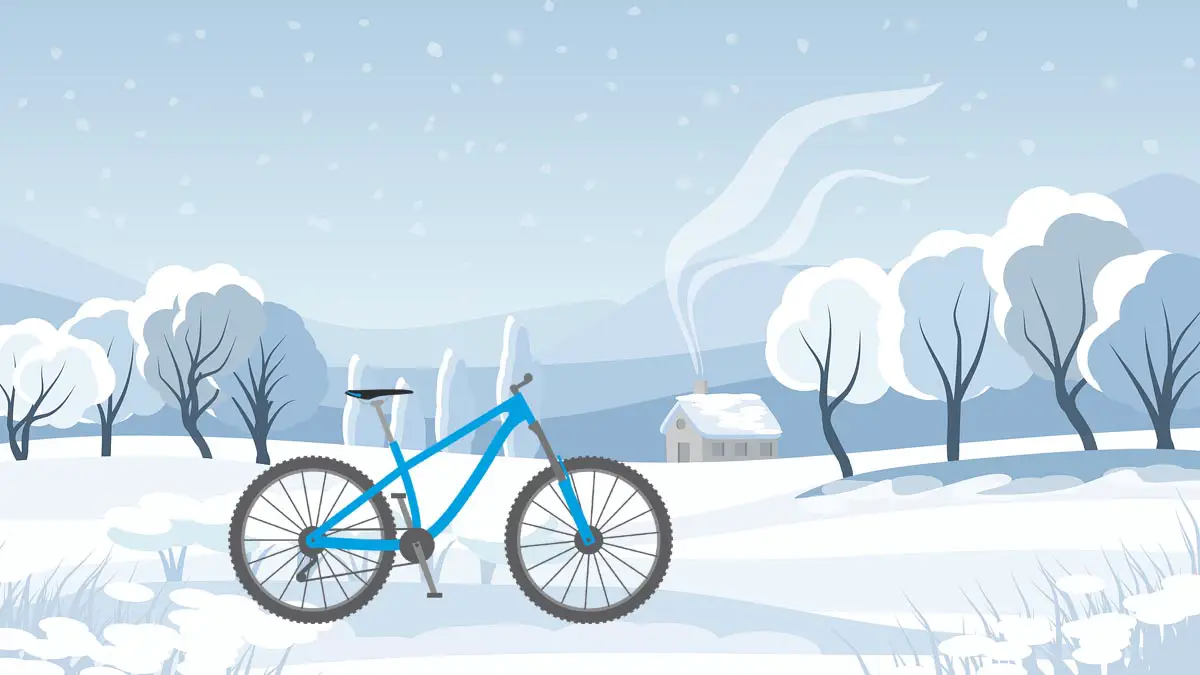
How To Prevent Bike Chain From Rusting?
Rusting on the bike chain would occur when it comes in contact with water due to oxidation impact on mental surfaces. It can be from riding the bike in rain, a bike wash, or being kept in storage where humidity levels are high such as the winter season.
To prevent the bike chain from rusting, you must immediately dry it out with the help of a paper towel or water-absorbing rag, followed by applying a bike chain lube to help seal it from water contact.
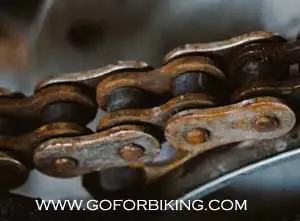
Can I Leave My Bike In The Garage During Winter?
You can leave your bike in the garage, as long as it is well insulated to prevent humidity levels from getting high. Make sure the rubber seal at the bottom of the garage door is not worn out, as it can have pockets of air to get inside with the door closed.
Instead of parking your bike on the garage floor, it is best to hang it on a wall or ceiling bracket that prevents tires from seating on the ground for too long potentially developing a worn spot on the tires. It also serves as a space saver by making the best use of your garage space.
How Does Rust Form on Bike Frame?
Just like any metal surface is impacted by oxidation due to humidity in the air or with direct water contact, bikes metal parts are also susceptible to oxidation leading to rust forming on the frame.
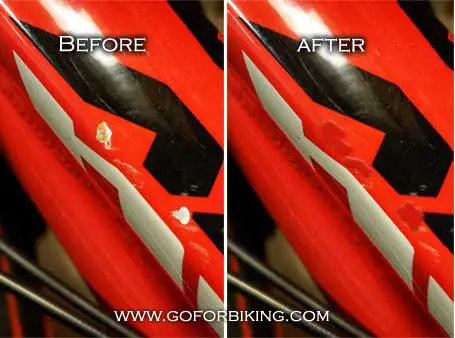
Usually, bike frames are coated and treated to protect them from rust, however with use normal wear and dents are common removing the protective coating getting that part explored to come in contact with humidity can get rust. Also, the inside of the frame tubes such as the seat post is not coated, so they can get rust.
An easy remedy to protect the frame from rust is to apply a matching color nail-polish coating on the dented surface immediately and apply grease on the inside tube of the seat post to prevent it from rust.
Is It Normal For A Bike To Rust?
Normally bike frames will not get rusted easily since they have a protective coating on them. However, poor maintenance habits and negligence can cause the bike frame to rust at scratched and dented areas with exposed metal surfaces, when left in humid environments for a long duration.
The best way to protect your bike from rust is to keep the frame dry and the drive assembly well lubricated.
Conclusion
Having a better understanding of the winter climate in your region, various factors impacting your bike during winter storage, and taking suggested protective measures discussed in this article shall help keep your bike lasting long so you can enjoy many rides out of it on your favorite tracks.
